IndusInd Bank’s performance in the June 2025 quarter has raised serious concerns among market participants and analysts. After earlier accounting irregularities and the resignation of its CEO in March, the bank’s operational metrics have taken a visible hit, further eroding investor confidence. As the Reserve Bank of India continues to monitor the situation closely, the spotlight now shifts to how the bank plans to regain momentum in an increasingly competitive banking environment.

The latest quarterly results present a mixed and largely discouraging picture. Net Interest Margin, one of the key indicators of a bank’s operational efficiency, fell sharply to 3.46 percent from 4.25 percent a year ago. This decline places IndusInd significantly below other private sector peers such as Kotak Mahindra Bank, which maintained a healthier margin of 4.65 percent in the same period. A reduction in repo rates by the central bank earlier this year has impacted lending rates, but deposit rates usually lag in response, further squeezing margins.
Loan book performance also reflected this broader strain. IndusInd Bank’s advances declined by 4 percent on a year-on-year basis, falling to Rs 3.33 lakh crore. In contrast, Kotak Mahindra Bank and Axis Bank reported growth in their loan books, with advances rising by 14 percent and 8 percent respectively. This underperformance indicates that IndusInd is losing market share at a time when credit demand is expected to recover.
The most alarming figures emerge in the bank’s provisioning. IndusInd set aside nearly Rs 1,760 crore in provisions during the quarter, a substantial 67 percent increase compared to the same period last year. This surge in provisions directly impacted the bottom line, with consolidated net profit falling by almost 72 percent to Rs 604 crore. These results include numbers from subsidiaries such as Bharat Financial Inclusion and IndusInd Marketing and Financial Services. Such a steep fall in earnings has left investors questioning the bank’s ability to turn around its operations in the near term.

Asset quality also deteriorated during the period. Net Non-Performing Assets rose to 1.12 percent compared to 0.6 percent a year earlier. The provision coverage ratio stands at 70 percent, which is lower than Kotak Mahindra Bank’s 77 percent, suggesting that IndusInd still has to catch up on provisioning buffers. Return on assets, a measure of how efficiently a bank generates profits from its assets, dropped to 0.45 percent annualised for the quarter, which is low when compared with sector averages.
Investor concerns are further amplified by the lack of clarity around the appointment of a new CEO. Leadership vacuum at the top can delay decision-making and strategic resets, both of which are crucial for any turnaround story. The RBI’s ongoing oversight remains a vital support mechanism, but without robust internal reforms, external supervision alone may not be sufficient to improve performance.

Market sentiment has already been affected. The stock price fell by 2.6 percent to Rs 802.1 at the start of the week and, while it is up from the March low of Rs 605.4, the recent trajectory shows investors are exercising caution. The bank’s valuation at more than 25 times estimated earnings for FY26 appears high, especially when compared to larger and more stable peers like HDFC Bank, which trades at over 20 times FY26 estimated earnings.
The macroeconomic backdrop presents opportunities, particularly with the central bank lowering the cost of credit and creating conditions conducive to lending. However, IndusInd’s ability to capitalise on this depends entirely on its leadership, internal controls, and strategic agility. Without immediate improvements in asset quality and earnings visibility, the bank risks falling further behind competitors.
Given the current uncertainties, many investors may prefer to keep the stock on their watchlist rather than making aggressive moves. With several critical quarters ahead and expectations building for stronger governance and operational clarity, IndusInd Bank faces a defining moment.
For more updates on banking news, financial insights, and stock market trends, follow You Finance on Instagram and Facebook. Stay informed, stay empowered.















